Contents
More than two hundred years ago, dahlias were brought to the European continent from hot Mexico. With their unpretentiousness and amazing beauty of the buds, they conquered a huge number of farmers, as evidenced by the fact that even today plants can be seen in almost every garden. A huge number of varieties of culture includes annuals and perennials, which are distinguished by thermophilicity. The lack of resistance to even the slightest frost does not allow dahlias to be left in the ground for the winter. That is why every year with the advent of autumn, it is necessary to dig up the roots of plants and lay them in storage before the onset of warm spring days. You need to store the roots in compliance with certain conditions and rules, more about which can be found below in the article.
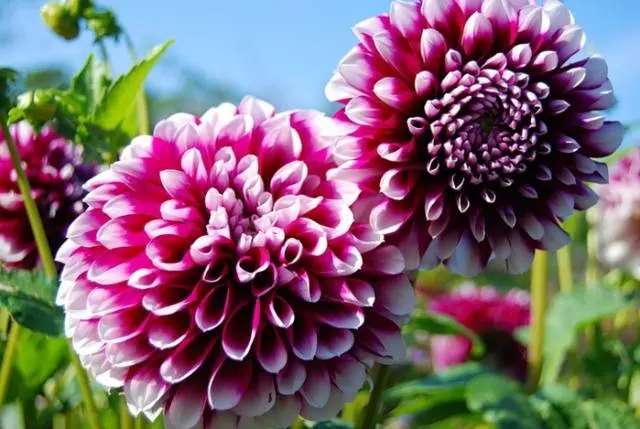
Time to dig up the roots
For winter storage, dahlia roots are dug up in the fall. This general thesis of many gardeners is confusing. The thing is that the autumn period is quite long, and the weather conditions may differ from year to year. For example, early digging of roots does not allow them to ripen, as a result of which the keeping quality of tubers worsens. Such roots often rot during storage and begin to germinate early. Digging up tubers late, during the period of severe frosts, you can completely lose planting material for the next year. Frozen leaves and stems of dahlias begin to rot quickly and can infect tubers with rot. It is impossible to leave dahlia tubers in the soil after the green mass has withered, because at the slightest warming, the growth of a renewal bud may begin.
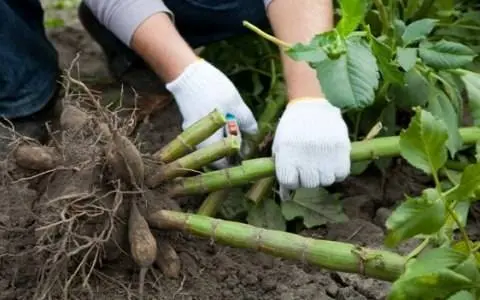
So, when to dig up dahlias for the winter, so as not to harm them? Of course, there is no single recommended date. Depending on the region, this may be the end of September or the beginning of November.
It is these symptoms that are the basis for digging dahlias. They indicate that the biochemical processes in the body of the plant are stopped, and the roots no longer consume nutrients from the soil.
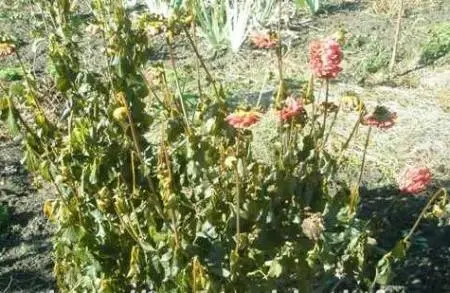
How to properly dig up dahlia roots
Dahlia roots are many thick tubers and thin long roots. Thin roots are intended to feed the tubers and do not retain their viability in the winter, so only tubers are stored for storage.
When digging up dahlias, you need to remember that next year the stems will form from existing growth buds. They are located at the bottom of the shoots. Therefore, before digging up the tubers, remove the bush itself, leaving the stems 10-15 cm high.
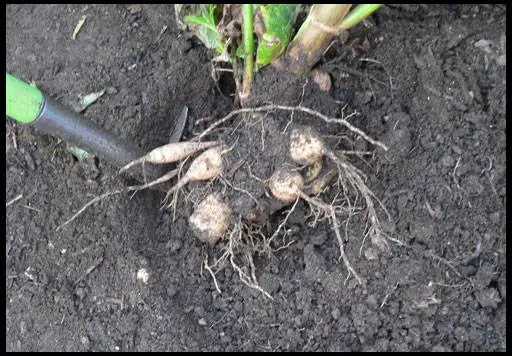
It is rather difficult to guess what size the dahlia roots themselves will be, therefore it is recommended to dig the root neck of the plant, stepping back 25-30 cm from it in each direction. Carefully removing the roots from the ground, they need to be shaken off and washed with water.
Root treatment before storage
After the initial cleaning, large dahlia roots can be separated. When dividing, each part must have a full-fledged thick tuber and part of the shoot with a growth bud. Each small piece of roots next year will be able to please with fresh greenery and beautiful flowers.
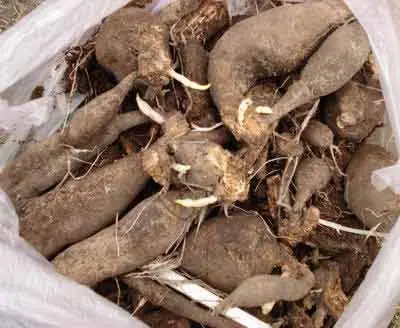
It is impossible to store damaged and diseased flower tubers. Even a small pocket of rot can destroy a large amount of planting material in contact with it during the winter. That is why when we remove dahlias for storage, it is necessary to carefully examine the tubers and remove dark spots, rotten areas on their surface. After such cleaning, it is necessary to additionally disinfect the planting material.
To disinfect the roots of dahlias, it is necessary to use a fungicide, for example, Fitosporin-M, Maxim. The fungicide can be replaced with a manganese solution. For processing, the roots of dahlias are dipped into the liquid for 10-15 minutes, after which they are thoroughly dried. Drying temperature should be approximately +15-+180C, the duration can be from 2 to 10 hours: the thicker the roots, the longer they need to be dried.
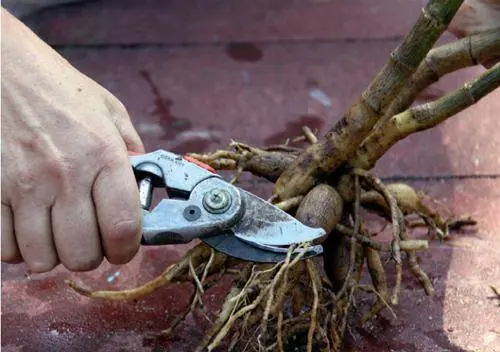
Dahlia digging is shown in the video:
A good example and comments from an experienced gardener will surely help you understand whether it is necessary to dig up plants for the winter and how to do it correctly.
Storage conditions
Dahlia tubers are stored for storage in a cool room, without access to sunlight. In a private country house, this can be a cellar or basement, a cold corridor. Storage temperature should be within +4…+60C. At elevated air temperatures, dahlia tubers begin to germinate, low temperatures lead to their freezing. By adjusting the temperature in the room, it is possible to influence the life cycles of the plant: if in early spring the dahlia renewal buds begin to sprout, then it is necessary to reduce the temperature to +30C. If it is necessary to artificially awaken seedlings for early cultivation, then the temperature must be raised to + 8 … + 100C.
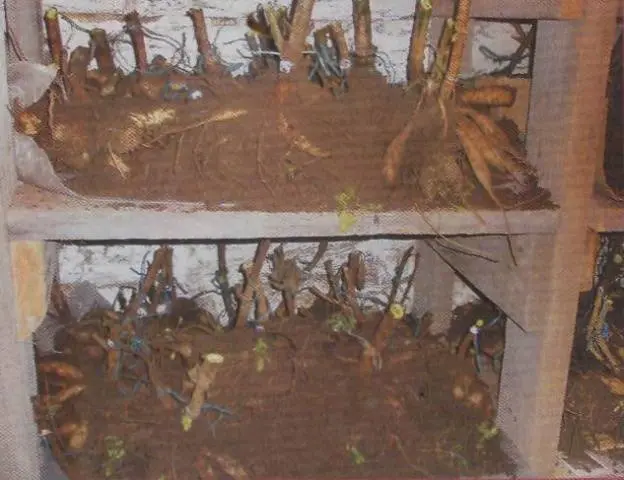
An important parameter in the storage of plant roots is humidity. The roots of dahlias in a room with high humidity quickly rot, a low level of humidity greatly dries out the tubers, as a result of which they lose their quality. The optimum humidity level is 60-70%.
Ways of storage
If the necessary microclimate parameters are strictly observed in the room, then the roots of dahlias can be stored in wooden or plastic boxes without much shelter. In this case, it is necessary to place containers with roots as far as possible from the stored root crops, since they can become a source of infection or “suck out” moisture from the tubers.
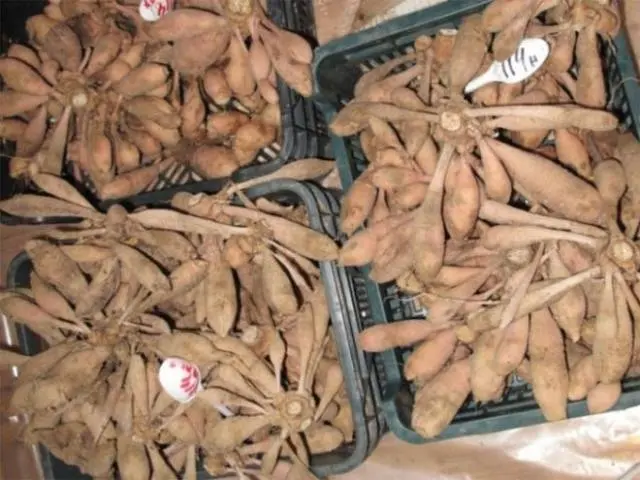
If the humidity or temperature does not meet the recommended parameters, then containers with non-hygroscopic filler can be used to preserve dahlias, for example:
- River sand is great for storing dahlia tubers. They fill the container and lay inside the roots in several layers. The sand does not dry out the tubers and does not allow them to rot.
- Peat is also used to store dahlias, similar to sand.
- Wood chips can protect dahlia roots from fluctuations in temperature and humidity. Choosing this filler for storing planting material, you need to make sure that sawdust is obtained as a result of working with conifers, and their fraction is as large as possible. When laying tubers in sawdust for storage, sealed plastic bags or buckets with a tight lid cannot be used as a container.
- Clay can be a good protection for dahlias removed from the flower bed during storage. A shell made of this material will reduce the effect of fluctuations in humidity in the room. Before use, the clay must be mixed in water until a homogeneous solution of a thick consistency is obtained. An additional ingredient in the mixture can be a spoonful of copper sulfate. These substances will protect the roots from the harmful effects of microorganisms. Dahlia tubers are dipped into the prepared clay solution and the shell is dried. As a rule, this takes 2-3 days.
- The paraffin shell is also able to protect the tubers from moisture fluctuations. To apply it, you need a few candles or a piece of paraffin to grate and melt in a steam bath. Tubers are dipped into the resulting viscous warm liquid. When cooled, the paraffin solidifies quickly, forming an airtight film on the surface of the planting material. A good example of how to wax dahlia tubers is shown in the video:How to store dahlias. How to wax tubers
- Vermiculite has excellent thermal insulation properties and a low level of hygroscopicity. It protects dahlia tubers from fluctuations in temperature and humidity, prevents premature germination of roots. Vermiculite is poured into a container, where dahlia tubers are subsequently laid out in layers. A layer of fine-grained material is also poured over the roots.
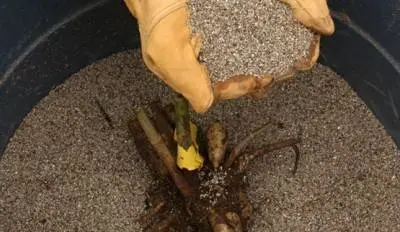
Dahlias should be stored in well-ventilated containers. These can be boxes or bags made of breathable material (cardboard, burlap) or open plastic containers. If mice or rats parasitize at the storage site, the tubers must also be protected from them. A good means of protection against rodents is wood ash. It can be poured into sand, sawdust or other filler for storing roots.
A difficult task can be the storage of dahlia roots in an apartment. The lack of space and necessary conditions force gardeners to regularly come up with new ways of storage. So, often containers with roots and filler can be seen on insulated balconies under shelter in the form of an old blanket or fur coat. At the slightest probability of freezing, containers with filler are placed in room conditions, near the entrance or balcony door. A simpler option for storing roots in an apartment is to place them in a refrigerator. Of course, only the farmer himself decides whether it is necessary to store a large amount of planting material, but the option is especially good when it comes to valuable crop varieties.
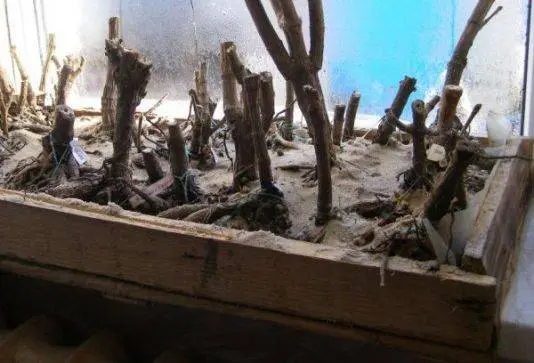
Results
Thus, the question of whether it is necessary to dig up the roots of dahlias can be given an unequivocal answer: of course, it is necessary. Otherwise, the tubers will die, unable to withstand the low winter temperatures. At the same time, each gardener decides on his own when to dig up dahlias and how to store them, based on the specific situation. We can only recommend adhering to the optimal conditions and the above methods of storage, recommendations on how to store tubers.









